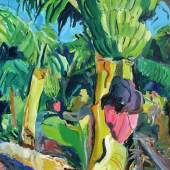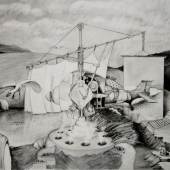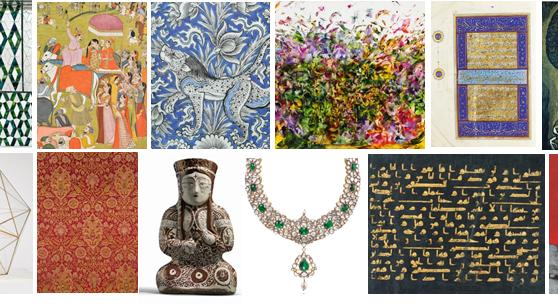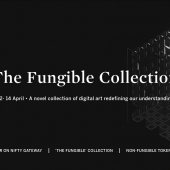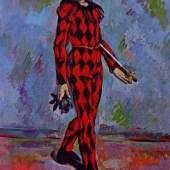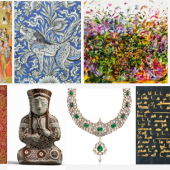1000 YEARS OF ART ACROSS THE ISLAMIC & INDIAN WORLD
-
Auktion23.10.2019
Benedict Carter, Sotheby’s Islamic Art specialist and Head of Sale, said: “Spanning several continents and centuries – with the earliest pieces stretching back to the seventh century – the selection showcases masterpieces of calligraphy, painting, ceramics, metalwork, jewellery and furniture. Viewed together, it is an undeniable testament to the sophisticated, inventive and diverse output of the Islamic world. Alongside our biannual sale, we are also thrilled to be presenting a stand-alone single-owner auction of just under a hundred manuscripts put together by a distinguished collector with an expert eye and eclectic taste.”
A LEAF FROM THE LEGENDARY ‘BLUE QUR’AN’
A large Qur’an leaf in gold Kufic script on blue vellum, Near East, North Africa or Southern Spain, 9th-10th century AD (est. £400,000-600,000)
This rare leaf is from an extraordinary manuscript referred to as
the ‘Blue Qur’an’, which when complete must have been one of
the most startlingly luxurious manuscripts produced in the
medieval Arab world. While the exact geographical origins and
story of the commission behind the manuscript remain elusive, it is universally agreed that the now enigmatic patron must have been a ruler of enormous wealth and ambition – the strikingly opulent dyed blue vellum and gold script sent a bold socio-political message to neighbouring empires.
INDIAN PAINTING
An illustration to the Bhagavata Purana: Kamsa attacks Devakni during her wedding procession, attributed to a Master of the First Generation after Nainsukh, India, circa 1780 (est. £200,000- 300,000)
This dynamic painting is from the celebrated Bhagavata Purana, remarkable for its effortless naturalism and deft and vivid rendering of figures in action. Works from this series are extremely rare in Western collections, and the last painting at auction was offered in 1992 at Sotheby’s.
This work depicts the dramatic scene when the evil King
Kamsa hears a voice prophesying that he will be killed by his
sister Devaki’s eighth son, and enraged, leaps towards Devaki
with his sword drawn – only stopped by the promise that the newlyweds would hand over all their future sons. The violence is set against the stately progress of the royal wedding procession as it moves across the green hills. This sudden murderous act attracts the attention of many of the entourage – with plenty of alarm and shock visible in their facial expressions – yet the cows, elephants and horses continue to march sedately across the landscape. The contrast achieves a composition that is both lyrical and dramatic.
THREE UNRECORDED PAGES FROM THE VICTORIA & ALBERT MUSEUM AKBARNAMA
The auction offers three previously unknown illustrations from the first illustrated royal copy of the Akbarnama – the official chronicle of Akbar’s reign, begun on the Mughal Emperor’s own orders in 1589. An important addition to the manuscript – 116 illustrations from which are held in the Victoria and Albert Museum – these pages record events in 1548, 1557 and 1574.
Akbar and his entourage journey by boat, illustrated page from the ‘First’ (Victoria and Albert Museum) Akbarnama, India, Mughal, circa 1590-95 (est. £20,000-30,000)
This episode relates to Akbar’s journey to the Eastern Provinces by boat in 1574, an expedition undertaken in order to quell a rebellion. Amidst the choppy water, Akbar himself is seated under a canopy in the central boat, which is elaborately designed with a dragon-head prow.
EXCEPTIONAL INDIAN JEWELLERY
A gem-set gold and enamelled sarpech, India, Benares, circa 1850 (est. £60,000-80,000)
Only the Mughal Emperor, his intimate relations and select
members of his entourage were permitted to wear a royal
turban ornament, and this triple sarpech is a particularly
elaborate example. During the reign of Shah Jahan, an ornate
jewelled brooch took the place of the heron feather in the turban, yet this example retains a stem for the insertion of the original feathered plume.
A diamond, ruby and emerald-set gold Manga Malai necklace, India, 19th century (est. £40,000-60,000)
The southern part of India is renowned for its fine golden jewellery, and pieces like this were traditionally worn for special occasions such as rituals or weddings. The Manga Malai – which directly translates to ‘necklace of mangoes’ – is unique to the ancient Tamil people, dating back to the thirteenth century. According to Hindu mythology, the mango fruit is a symbol of love and fertility, and the principal elements of the design represent nature, with various forms of flowers, leaves, fruits and buds.
A 363.9 carat Mughal emerald crystal set in enamelled mount with seed- pearl string necklace, North India, 18th century (est. £10,000-15,000)
In Mughal India, emeralds were associated with fertility and were believed to aid good vision. During this period, such gemstones were mined in Columbia and reached India via Spanish merchants as trade goods and a strong relationship was forged, with the Mughals purchasing the largest and finest quality emeralds. This necklace is a rare example of an emerald being mounted in its crystalline form, in order to flaunt its size.
A MONUMENTAL SAFAVID CELESTIAL GLOBE
An elegant Safavid brass celestial globe and frame, 17th-century Persia (est. £80,000-120,000)
-
20.04.2022ARTEXPO NEW YORK CELEBRATES ITS 45TH ANNUAL EDITION WITH A RENAISSANCE IN CONTEMPORARY AND FINE...
-
12.04.2021 - 14.04.2021By Pak • 12- 14 April • A novel collection of digital art redefining our understanding...
-
23.05.2018NEW YORK, 16 May 2018 – Today, Sotheby’s is honored to unveil the full contents of A...
-
Diese Suche nach der "reinen Malerei" findet auch in verschiedensten Theorien und...
-
11.12.2024Iconic Heuer Monaco Worn by Steve McQueen in LeMansRaces to Auction at Sotheby’s New York...
-
23.10.2019Auktion »
20TH CENTURY ART / MIDDLE EAST, SOTHEBY’S LONDON Auction: 22 October
Public View: 18-22 October

